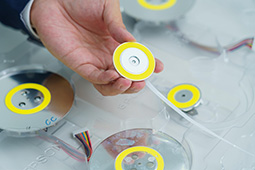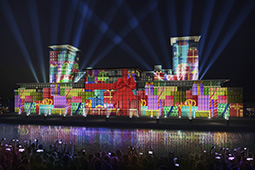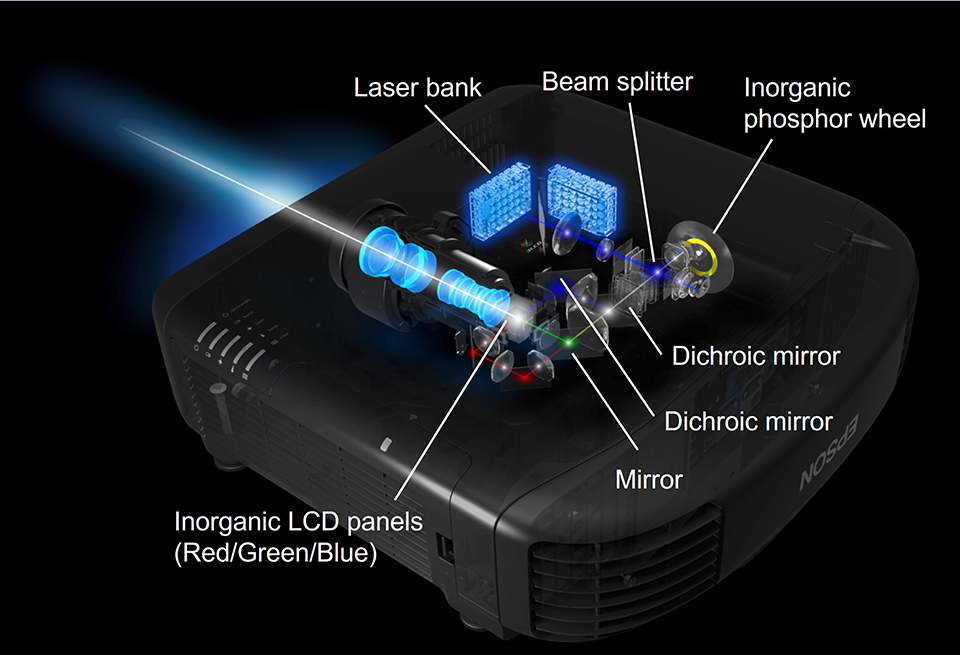July 2022
Projectors with a Laser Light Source Expanding the Potential of Light

Images of fish and jellyfish swimming are projected onto a building’s walls in an example of Epson’s CSR activity Fantas Aquarium -

Toyooka Takashi (left) and Zakoji Makoto (right) with Epson’s laser projectors

The three primary colors of light. White is produced when red, green, and blue overlap. White is also produced when yellow and blue overlap 
Yellow phosphor applied to disks. When illuminated by a blue laser light source, the disk reflects yellow light 
A CG image of projection mapping on a building by laser projectors

Laser projectors that are compact, lightweight, and capable of projecting bright, beautiful images are expanding the range of possibilities for visual expression within a variety of settings.

A projector is a device that projects enlarged images of data from sources such as a computer monitor, TV program, or Internet video-streaming onto a screen or other surface. Traditionally used for presentations within a variety of settings, such as classrooms, academic conferences, and press conferences, more recently their potential has expanded to entertainment. Projectors can be utilized for a variety of purposes both inside and outside, such as for public viewing of sports events on a big screen, the presentation of digital arts in museums and galleries, and projection mapping. Among the projectors used for entertainment, the high-brightness, high-image-quality projectors using a laser light source developed by Seiko Epson Corporation (hereinafter, Epson) have been attracting attention.
The key feature of these projectors with a laser light source is that they can generate a variety of colors from a monochromatic laser light source. Most projectors in general use currently are liquid crystal projectors. With this type of projector, white light emitted from a lamp is first broken down into the three primary component colors of red, green, and blue, which are then transmitted to three separate dedicated liquid crystal panels. The three primary colors are then combined to form the projected image. Combining the three primary colors of light enables various colors to be created (see figure).

When these projectors first came on the market some thirty years ago, they were primarily utilized for displaying documents in conference rooms and for home theaters. Since the 2010s, however, they have also been used for giant screens in large-scale venues and for projection mapping and similar events. To cater to this application, manufacturers began to produce liquid crystal projectors fitted with multiple large lamps that produce brighter and larger images. However, due to the need to accommodate multiple large lamps, the body of these projectors was significantly larger. In addition, projectors using lamps as the light source needed to have their lamps replaced periodically. Basically, such projectors also have to be positioned horizontally. Laser projectors were developed to overcome these challenges.
“The laser projector we developed features a blue laser as its light source, which is brighter than a lamp and has a longer lifespan,” says Toyooka Takashi of Epson’s Visual Products Operations Division. “A blue laser cannot be the only light source for a projector, however. We needed to produce the other primary colors of red and green with the blue laser.”

An easy solution would be to use red and green laser light sources, but this would make the projector larger and more costly. Further, a low-cost white laser source with adequate performance is yet to be developed. How to generate a wide range of colors utilizing only a blue laser light source was a significant obstacle to overcome.
The research team led by Toyooka and his colleague Zakoji Makoto came up with the idea of producing white light from a blue light source. If white light can be produced, it can be separated into red and green. To create white light, the team came up with the idea of using phosphors, which emit the light of another color when exposed to light. Since white light can be produced by combining yellow and blue light, the research team used phosphors that emit a yellow light when illuminated by a blue laser beam.
Although the research team succeeded in producing white light, there was a drawback: If the laser was kept on a single point, the resulting high temperature would cause the phosphor to degrade. To remedy this issue, the team devised the technique of rotating a disk to which phosphor has been applied and shining a laser beam on it to prevent the laser beam from continuously hitting a single point.

This projector offered numerous advantages over conventional projectors using lamp light sources. The laser light source is very bright, enabling clear images to be projected onto giant screens installed in large halls and auditoriums. In addition, it becomes possible to efficiently transmit light to smaller liquid crystal panels by using the laser light source, which makes for a more compact projector body. The laser light source has a very long lifespan, reducing running costs and environmental impact. What is more, the projector can be placed in any position because there are no limits on the angle at which the projector sits. This makes it possible to completely cover entire spaces with the projected images. This has made a contribution to the development of culture and the arts such as in the digital art genre. In recognition of these merits, “The Invention of a High-Brightness, High-Image-Quality Projector using Monochromatic Laser Light Source” was awarded the Prime Minister’s Prize at the 2021 National Commendation for Invention sponsored by the Japan Institute of Invention and Innovation.
Epson is using these projectors in a corporate social responsibility (CSR) activity called Fantas Aquarium. This is an initiative to provide stimulating experiences by projecting moving images such as fish, jellyfish and plants onto interior walls or screens, mainly at hospitals and special-needs schools.
Projectors with a laser light source that are lightweight and compact and can project bright and beautiful images are sure to be utilized within a wide variety of settings in the future.


